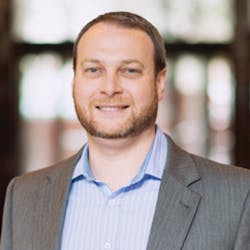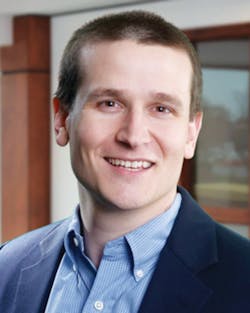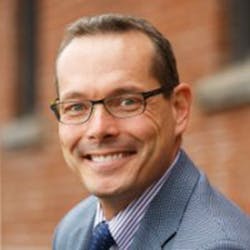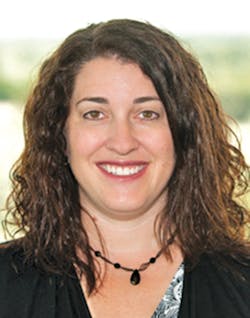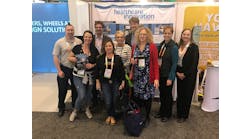Here in the pages of HMT we sometimes see the same faces. For this Rising Stars feature, we wanted to do something a little different. The leaders you’ll read about in this article have never appeared in HMT before – though thanks to their friends and colleagues who nominated each of them for their unique passions, they are on our radar now.
The healthcare professionals you see here were chosen because they are actively inventing solutions, solving problems, and making a real difference in their communities. They’re smart, ambitious, and, while they have accomplished a lot in their leadership roles, they still have a lot more to do. Here they talk about their successes, failures, vision for the future, and even a little about their personal lives.
Without further introduction, here are your HMT Rising Stars of HIT Leadership for 2016.
Chris Heckler is the President and CEO of Valify, a purchased services analytics and benchmarking company. Valify is the only online software that quickly categorizes purchased services vendors, allowing health systems to easily identify and track savings opportunities within these categories.
Heckler brings more than 12 years of healthcare contracting experience with success in the purchased services categories. Before launching Valify, he was the Director of Purchased Services for the Texas Purchasing Coalition (TPC) from 2010 to 2014. In that role, he was responsible for collaborating with all levels of management within the membership to develop, implement, manage, and grow a portfolio of purchased services contracts and committed programs.
In your own words, can you provide some detail on your background, up to and including your present role?
I started working at Novation (now called Vizient) after I graduated from Baylor University. I started as a business analyst and worked my way up to Sr. Product Manager. I left Novation to run a bar my wife and I bought. After a couple of years, the economy tanked and we had a newborn, so I sold the bar and went back to my GPO [group purchasing organizations] roots. I started working at Texas Purchasing Coalition (TPC) as the Director of Purchased Services, which is a regional GPO that used to be an affiliate of Novation. When I started, TPC had just left Novation and joined MedAssets, another national GPO (also now owned by Vizient).
My job was to find savings opportunities in the purchased services space across 45+ hospitals in Texas that were members of TPC. We were flying blind with zero data or intelligence, so the first thing I did was request the collection of all of our hospitals’ accounts payable information. It was like pulling teeth, but we ended up getting most of the information we needed.
Unfortunately, each hospital spelled every vendor differently, and there were no standard categorization methodologies; it was a labor-intensive process to aggregate the data in Excel. It would take four to six months just to collect the data and get it all cleaned up. This is back in 2013, and I was like, “How is there not a software that can do this for us?” I worked with MedAssets because they had a ton of technology, but it wouldn’t work for purchased services spend because this spend doesn’t have product numbers or IDs, which is what their software used for cross-referencing and categorization.
I was working on my MBA at the time, and one of the assignments was to come up with three strategic alternatives to our current business. One of mine was to create a software that categorized and benchmarked purchased services spend. My professor told me it was a great idea, but I told him I didn’t have any software development experience. He told me to find someone who did.
I ended up running across an old fraternity brother on LinkedIn, and his title was Sr. VP of Software Development at a healthcare company. After a few lunches, he proved to me he could build it, and I proved to him there was a market.
I quit my job and started Valify in March 2014. I self-funded the company doing product market fit comparisons and trying to raise our seed round of funding. We closed that round on September 2014 – and Matt Clark, my business partner, quit his job and joined Valify full time to build the software.
We launched the software on New Year’s Day in 2015, and I started selling it. Our first client, Aurora Healthcare, signed up in March 2015. That was enough to validate the market, and the sales started flowing in.
What professional failure have you experienced, and how didyou grow from it?
The bar I owned failed, and I couldn’t file for bankruptcy because my in-laws co-signed the loan I took out to buy the business. It was a devastating blow to me personally and put an incredible amount of stress on my marriage because of her parents being involved.
It took me probably 12 months to go through the stages of dealing with such a failure until I finally realized there were a ton of major business lessons learned that I will never repeat. I had to suck it up and go back into the corporate world to start providing for my family again.
The major lesson learned is that even though I lost all of our money and a lot of my family’s money, I could earn it back. It wasn’t life or death, even though at the time it felt like it was. I took a lower paying job to get my family back on their feet and started paying my in-laws back each month.
What person, figure, work, or group do you look to as inspiring?
I’m incredibly lucky to have Chris Drake as an investor and board member. He has taught me an unbelievable amount about building, running, and growing a technology company. He started his company, Armor.com, years ago and has gone through every stage and issue that comes up at Valify. He helps me personally and professionally pretty much on a weekly basis.
Do you have any advice for others in the healthcare tech space?
Quickly establish at least one customer champion that will tell anyone that will listen about how great you are. Those first innovators that are taking a risk with you are crucial in healthcare because nobody wants to be first. You need their references, case studies, and logos to prove that your technology actually does what you say it does. Don’t be afraid to give them discounts for being first. You can always adjust pricing later.
Looking forward, what is something you would like the healthcare industry to accomplish?
Besides figuring out how to take better care of our veterans and elderly, I wish there was a mandate that required all hospitals to look at non-labor cost reductions prior to terminating any patient-facing employee.
It really bothers me when I read about a hospital or health system that is letting go of nurses and other employees, because I know for a fact that they have not looked under every stone for vendor cost reductions first.
We help our clients save tens of millions of dollars each year, and we know we could help the industry reduce vendor costs by at least $10 billion.
As the Director of Innovation at Medfusion, a provider of patient experience management solutions based in Cary, NC, Fierer brings over a decade of experience in product development. Since joining Medfusion, Fierer has served as product team leader, driving and supporting the end-to-end vision and execution of the company’s SaaS-based healthcare platform. Additionally, Fierer heads the development of technology that enhances mobile user experiences for the company’s patient, provider, and community-based organizations.
Prior to his current role, Fierer was a software engineer, where he was responsible for API platform development and support, legacy, and new feature implementation. Fierer also served as a senior sales engineer at Intuit, where he worked to develop and maintain the company’s portal technology for consumer distribution.
In your own words, can you provide some detail on your background, up to and including your present role?
On a day-to-day basis, I am leading strategy and product for our mobile and API teams, which are very hands on and both patient and developer focused. I never dreamed of doing what I am doing today, but am thankful the steps along the way led down this path. The path included an undergraduate degree in Computer Science at Virginia Tech (Go Hokies!), several years writing web applications and APIs, a transition to sales engineering, followed by product management roles. The blend of technical, business, and people-facing roles along with great mentors and leadership has helped me get to where I am today.
What is the most rewarding aspect of your current role?
The most rewarding aspect of my current role is working with an incredible team of people. Each person cares about the mission we are on, the problem we are solving, and carries their weight daily. We push each other to do the right thing so that we can serve our customers better each day. When we show up and do our jobs, we know we can make a positive difference in the lives of others.
What professional failure have you experienced, and how did
you grow from it?
In one of my earlier product management roles, I learned a very valuable lesson around internal communication and cross-functional alignment. Making sure every key stakeholder is heard regarding their opinions and concerns is a time-consuming and delicate process. I made the mistake of not having everyone on board a couple of times and, as a result, caused unnecessary delays and wasted the time of many team members. It pushed me to be more intentional about keeping everyone aligned, communicating along the way, and giving cross-functional teams enough runway to collectively move an initiative forward in a successful way.
What person, figure, work, or group do you look to as inspiring?
My wife Lindsey. My parents, my sisters, my in-laws – they all have or continue to inspire me in some way. A few others that make the list: Dave Ramsey, Seth Godin, Brene Brown, Jim Collins, and Donald Miller.
What project have you worked on that required the most creativity?
Being a dad to two kiddos (with twins on the way). It’s a huge shift in your identity and redefines the very definition of “time management.” Even when it feels like the wheels are about to fall off, I am in some way reminded daily of what’s most important. It’s easily the best “project” I have worked on.
What’s next for your professional career? Where do you see yourself in the future?
I believe there is still more work to be done in my current role. Given the journey so far, I look forward to the opportunities that lay ahead. I think that healthcare will be a great market to work in for the next several decades, especially as we see tech from adjacent verticals beginning to find their place here. I am most excited about APIs, patient-centric interoperability, and relevant applications for machine-learning and automation.
Off the clock: What’s your favorite way to spend free time?
Spending time with my family – nothing quite beats it. Early morning runs, hiking, reading, and a little guitar also bring balance to a world and life that constantly asks for your attention.
Shaun T. Alfreds serves as Chief Operating Officer of HealthInfoNet, a health information services organization that operates Maine’s statewide health information exchange (HIE) – a secure, standardized electronic system where healthcare providers can share important patient health information for treatment purposes.
Based in Portland, ME, HealthInfoNet is an independent, nonprofit organization, but Alfreds says the secret to the nonprofit’s success is that it is run like a business. All 37 of the state’s hospitals – plus more than 500 ambulatory sites – belong to the exchange and pay a fee for participation, which supports the operating capital needed to run the organization.
As COO for the past six years, Alfreds oversees all of HealthInfoNet’s business and operational activities. He has more than 15 years of experience overseeing programs that support consulting, research, and policy development in the areas of health information technology and health information exchange.
He received a Master’s in Business Administration from the University of Maine and is a Certified Professional in Health Information Technology.
What is the most rewarding aspect of your current role?
I work in one of the most exciting and ever-changing technology sectors of the U.S. economy: healthcare IT. I was able, early on in my career, to cut my teeth understanding the complex policy drivers for health and working in this space as an advisor to the federal government, states, and high-level officials. They provided me with a good sense of the ecosystem that technology was operating within. Having now the opportunity to be on the implementation side of bleeding-edge technology in the healthcare sector is both extremely challenging and rewarding. I find myself spending a lot of time just understanding new technologies and comparing them to what works today, using the lens of what is possible versus what is practical. The people I have the opportunity to work with are amazing. I get the chance to work with and be advised by the most brilliant clinical experts across the state of Maine and at a national level. More excitingly, I get to take that advice back to HealthInfoNet and share it across a team of highly intelligent, motivated, and mission-driven people. What our small team of 20 people has done is mind-boggling sometimes. The creativity, technical skill, dedication, and ingenuity of our people has made HealthInfoNet successful, and it is what motivates me to come to work every day.
Detail a past project that turned out differently than you planned.
As the centralized hub for healthcare information across the state of Maine, HealthInfoNet has the role of aggregating patient record data from the entire state. This wealth of information has so much value both to the provider community and the patients themselves. As a mission-driven organization, we committed from day one that once we were able to collect a critical mass of patient data, organize it, and make it useful, we would then make it available to patients. While the business model for aggregated patient portals was not yet clear, we at HealthInfoNet decided that we were in the right place to make this happen in 2010. We partnered with a Canadian company and built out a patient record platform that allowed patients a place to both semantically input data (that would then be coded in medical terms) and they could see their medical data from all providers that are participating in the health information exchange. The system was operational, and we thought we had something that was innovative, easy to use, and functional. Well, we did, but the timing was wrong.
As we began to deploy this tool, our clients (the provider community) in the state came forward to us and asked us to stop. The reality that we did not anticipate was the impact of the HITECH Act. Specifically, in the EHR requirements for Meaningful Use, hospitals and eligible providers were required to make electronic information available to patients within a specified time period for their patients and allow the patient to conduct specific functions electronically such as scheduling. The specifics of this rule made it very challenging for a third-party organization like HealthInfoNet to implement due to the tight integration required with the local EHR and practice management systems. Moreover, the leaders of some of our largest health systems came forward to us (remember they are our biggest clients), asking us to refrain from releasing an aggregated personal health portal as it would compete with their strategies for marketing their EHR-based patient portals and potentially disrupt their Meaningful Use payments.
What person, figure, work, or group do you look to as inspiring?
I am inspired by the work of many people. One person that comes to mind quickly is Elon Musk. Whether space travel or renewable energy, his vision for thinking big and breaking down boundaries is something that I aspire to every day. His biography is worth reading if you haven’t. This kind of long-term vision tied to demonstrated short-term successes (and failures) was drilled in to me from graduate school. I have been fortunate to have some significant mentors in both my education and professional life, each of them imbued upon me different perspectives – management, health policy, and IT best practices. These people taught me to push boundaries, think big, learn from adversity, and to keep trying.
As I see it, we always need to question the paradigm of what we are working on and always find the holes and opportunities. We need to have a vision that outstretches our current capabilities to be able to tackle the hard problems we are facing today. We have to listen to our peers and be vigilant – for both positive and negative feedback, and we need to inspire teams and deliver success.
Do you have any advice for others in the healthcare tech space?
Work hard. Listen to your peers. Find mentors. Have a vision. We learn more from adversity than successes, so embrace it. Finally, health IT is so fluid, make it fun and real. I always tell people I have a 51 percent rule. If I don’t love my job more than 51 percent of the time, then I am in the wrong spot. This may not sound like a lot, but the reality is that work is hard most of the time, and if we can truly enjoy it a slight majority of the time, then we are growing and working in the right place. And last but not least, remember what and who we are doing this for: Improve the health and wellness of the patient.
Looking forward, what is something you would like the healthcare industry to accomplish?
Working in this sector is personal for me, as I am sure it is for others. My daughter was diagnosed with Type 1 diabetes at age 5. This disease, while manageable, is very challenging. Essentially, we as parents have to be her pancreas and deliver insulin to her body for every carbohydrate she eats and for all the hormones that cause her body to produce glucose. It is incredibly data dependent to keep her average blood glucose in a normal range. We have been so lucky to be going through this at a time when there are technologies available to us. She has a continuous glucose monitor that uses Bluetooth technology to communicate to a phone that then pushes her current and average blood glucose to my, my wife’s, and her school nurses’ phones and iPads. My wife and I have watches that pull data from an application programming interface (API) on our devices so that we can get alarmed without having a device even open.
I could not live without this technology anymore. It allows my daughter to self-manage better, as she can see her blood glucose in her routine activities. It also allows her to stay as safe as possible as there are three adults monitoring her levels remotely while she is at school or doing extracurricular activities. My daughter is growing up in the technology age, which allows her to monitor her health and receive the right level of insulin every day, and I am thankful.
This is the type of technology that motivates me and I would like to see proliferate; not just for diabetes but for our daily lives. The key to moving the healthcare sector in the modern age is to shift the paradigm of “treating the sick” to “keeping people well.” This is where I believe technology is critical – whether it is smart monitoring devices like I use with my daughter, vital sign monitors, smart scales embedded into a kitchen rug, or GPS tracking and communications to help people find the healthiest foods. These tools are available today and represent the tip of the iceberg when it comes to technology that can keep us well.
There is an important model of care emerging in our field: precision medicine. I think there are so many opportunities here – but it requires us to think of data in whole new different ways. Experts, with much greater education and experience than I have, stated that the medical data on a person only represents 20 percent of the information that is necessary to promote wellness. That 80 percent of data –social, genetic, and other – is where I want to see our industry focus and where I would like to have an impact.
Dr. Nelson obtained her medical degree from The University of Arizona College of Medicine, where she received the prestigious Alpha Omega Alpha distinction and was named Arizona’s 2001 Outstanding Senior Medical Student in Family Practice.
Following medical school, Dr. Nelson completed three years of specialty training in family medicine at Banner Good Samaritan, where she served as chief resident and was nominated for the James-Grobe Award for excellence in family medicine. Dr. Nelson was chosen to be part of the inaugural class of Health IT Fellows by the Office of the National Coordinator.
Dr. Nelson has been recognized by U.S. News & World Report as one of nine Top Doctors in Family Medicine for Phoenix (2012). She was selected as one of Phoenix Magazine’s 2009 Top Doctors for Family Medicine in the publication’s annual list of the Valley’s Best Physicians.
Desert Ridge Family Physicians in Phoenix, a practice Dr. Nelson founded in 2004, has received several accolades as well, including NextGen’s Best Small Practice Award, the Intel Innovation Award, and the Arizona Republic’s Most Family Friendly Primary Care Office.
What is the most rewarding aspect of your current position?
I am very fortunate to wear two hats. As a frontline physician, I take great satisfaction in the relationships that I have formed with my patients, in the care that I provide, and the trust that they put in me. But I also see the frustrations of our medical system, and the impact that it has on both patients and the providers of care. As the Chief Strategy Officer of our accountable care organizations (ACO), these frustrations serve as my motivation to improve the system. I am very proud to have contributed to the improvement of care provided by my community.
What professional failure have you experienced, and how did you grow from it?
I have taken many risks throughout my career. There are times I have gone against conventional wisdom or the recommendations of trusted advisers. I have been told that I was naïve, that my ideas would not work, and to lower my aspirations. I have learned three things from these experiences. First, I learned that I feed off my passion. I aim high, I’m idealistic, and I’m eager to contribute. Secondly, I’ve learned to trust my gut. There are difficult decisions to make, and we are often in unfamiliar territory. I trust my gut, and I speak my mind. My track record is strong. And third, I surround myself with smart, talented people. Much of the credit for my successes goes to their contributions.
Looking forward, what is something you would like the healthcare industry to accomplish?
Reestablish the role of physicians from data entry clerks to healers. The medical system must develop new sources for its insatiable hunger for data. I understand the importance of the data and the benefits it can yield. But we can’t continue asking physicians to take their focus off the patient in order to type and click every utterance, search through multiple coding systems, and document insignificance for the benefit of payers and statisticians.
Name one piece of technology you just can’t imagine life without.
I have found salvation through the use of Google Calendars. My husband and I have three very active children, who collectively play on five sports teams for most the year. Each of our kids has their own Google Calendar, which tracks the times and locations of their practices, games and tournaments, as well as drop-off and pick-up duty. Each of the calendars is shared with four incredibly supportive grandparents, who assist in rides and cheering. Without Google Calendars, I would need a personal assistant just to keep up with the coordination.
What’s next for your professional career? Where do you see yourself in the future?
I love what I do. I find great fulfillment in my connection with my patients, and my contributions to my community. Without concentrating on my specific role, I am excited about the promise of using predictive analytics to impact care. We have already seen proactive investments in health and well-being yield both savings and tangible improvements in quality of life for people.

